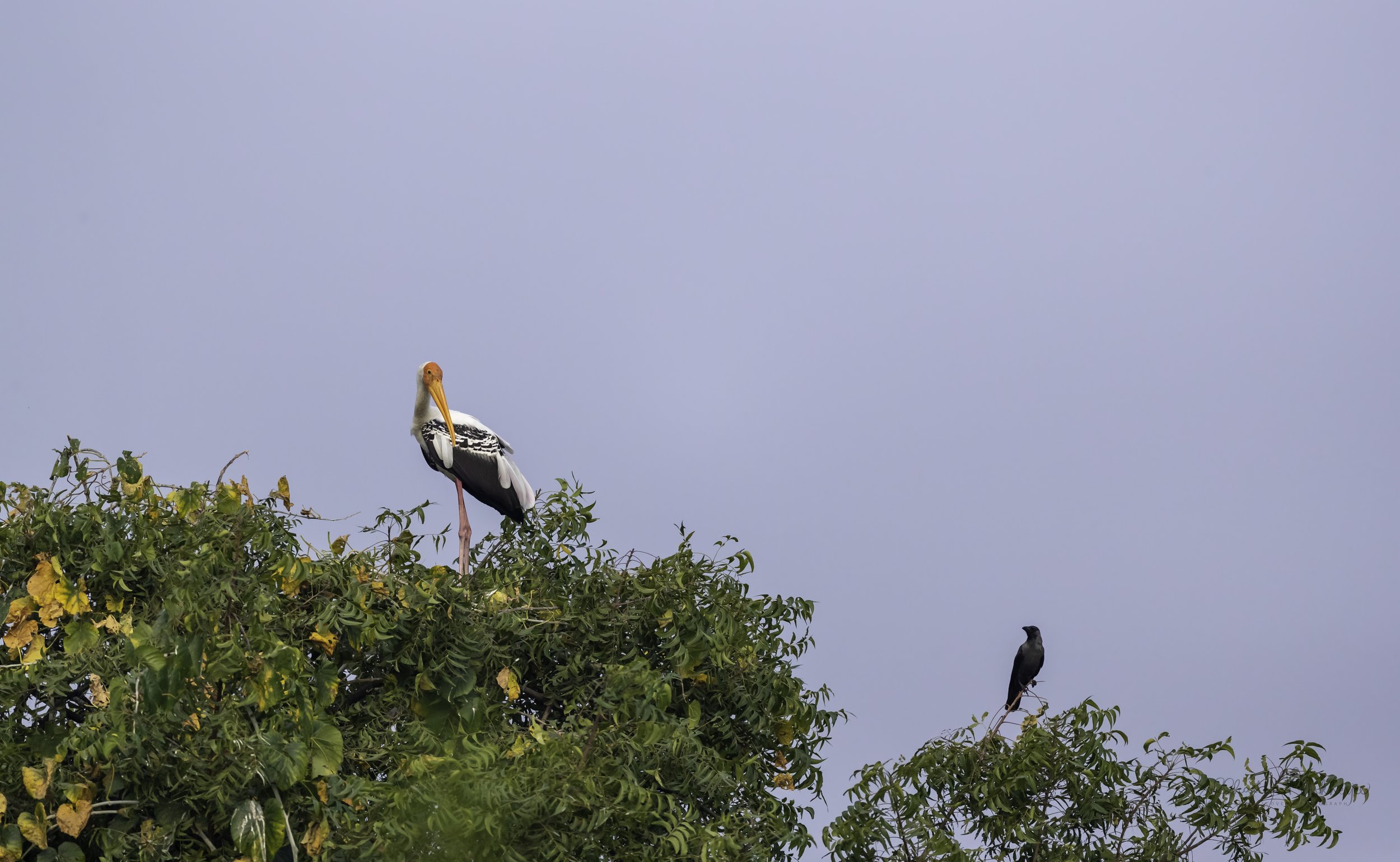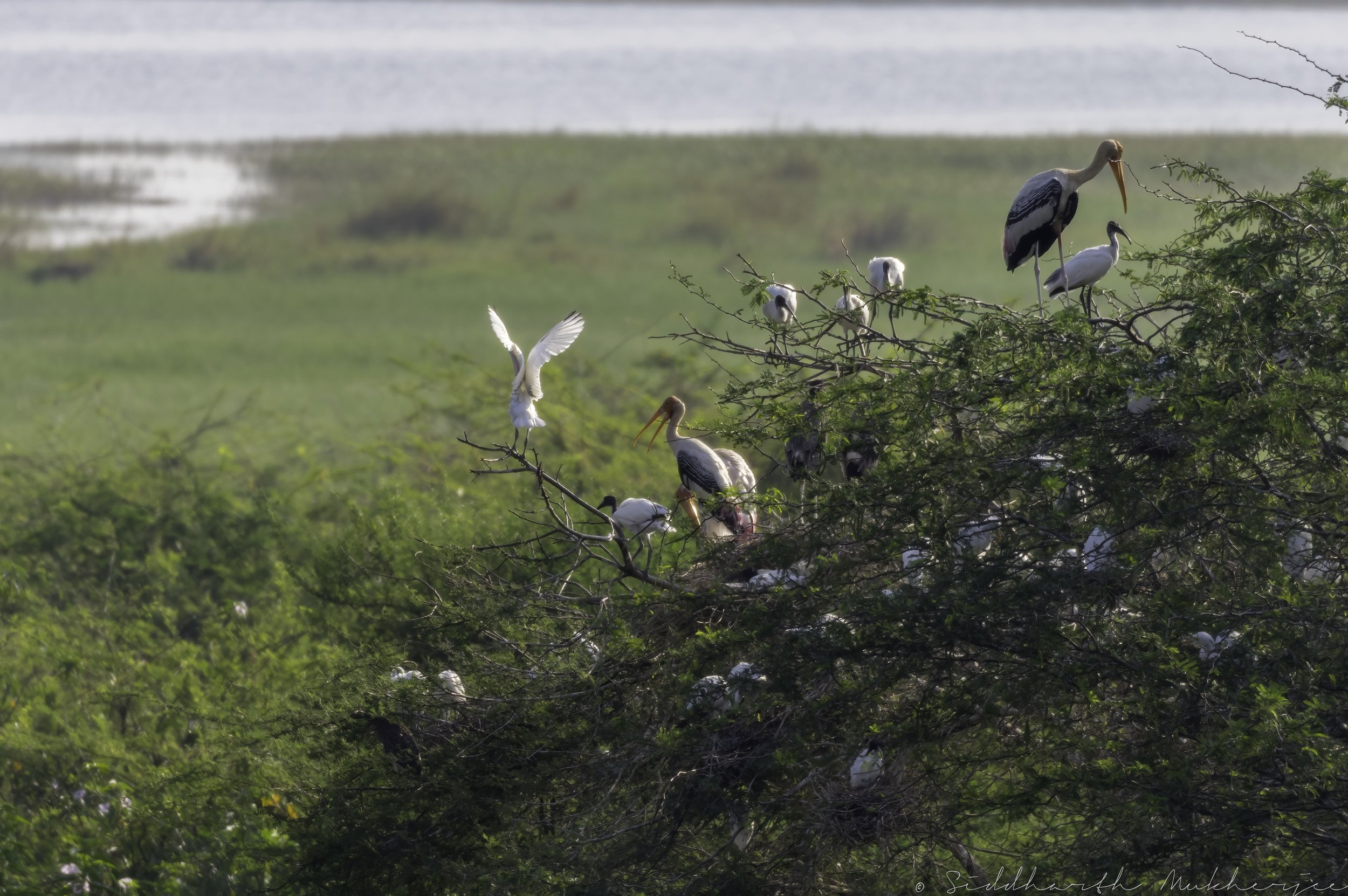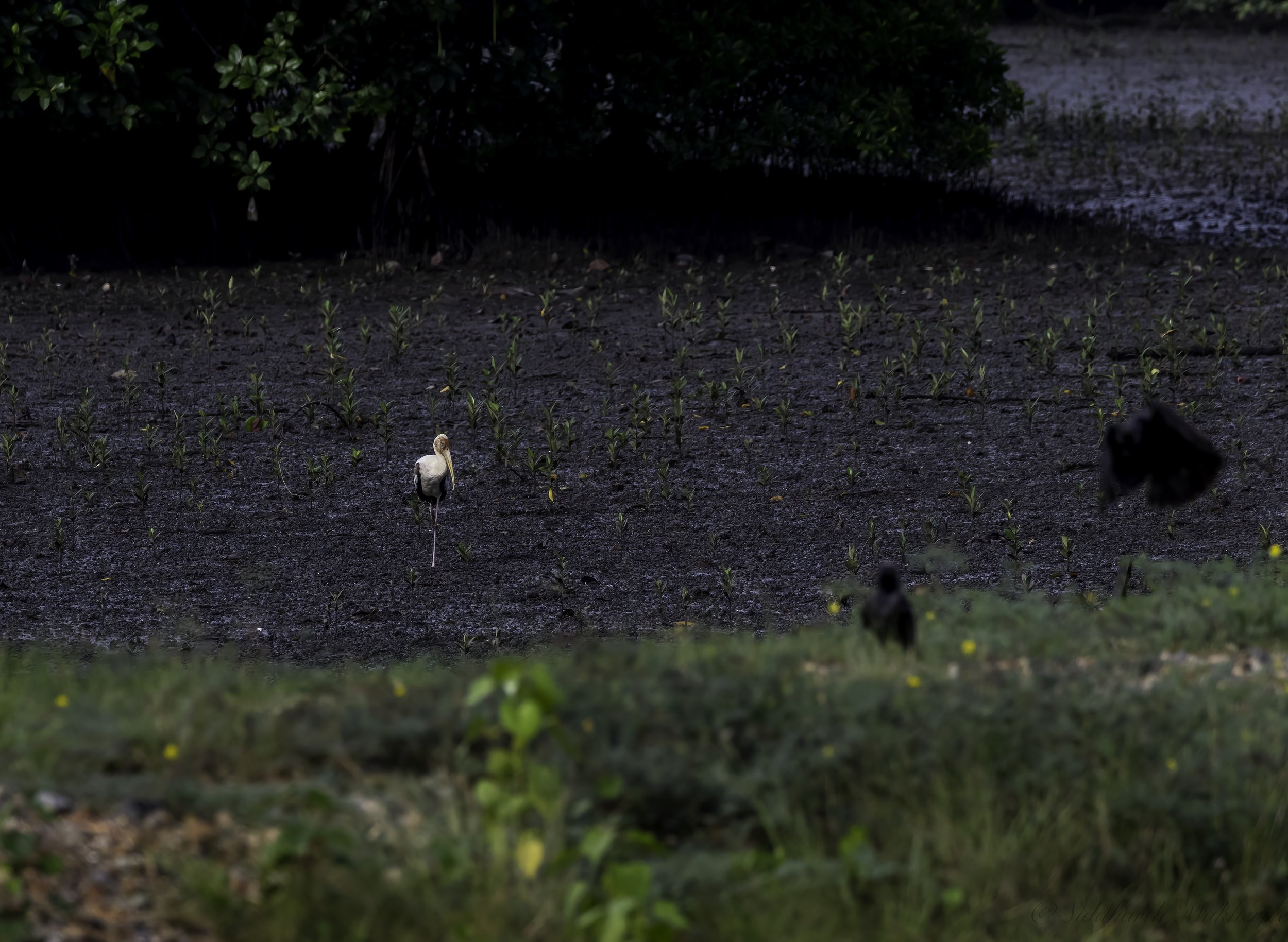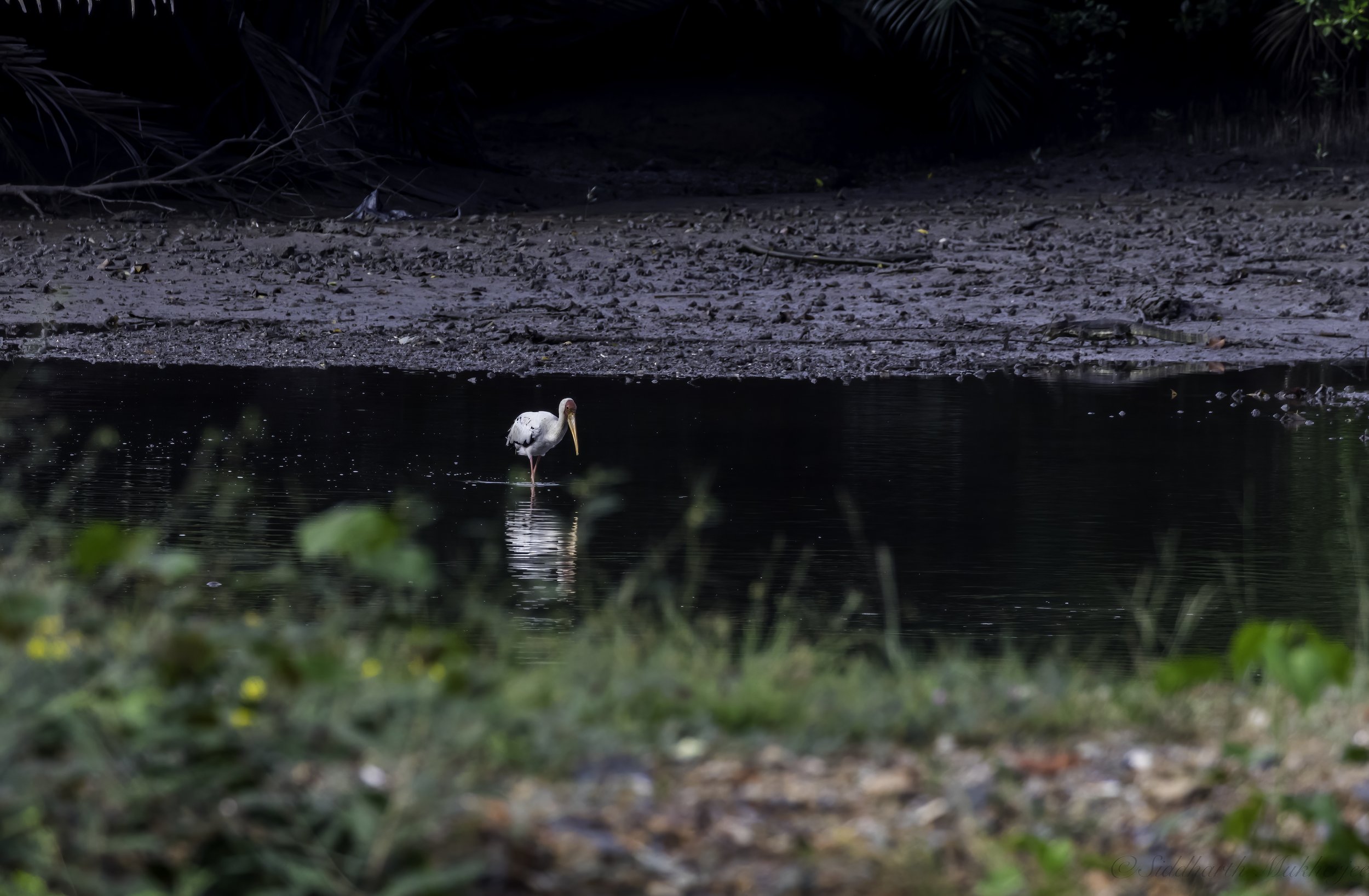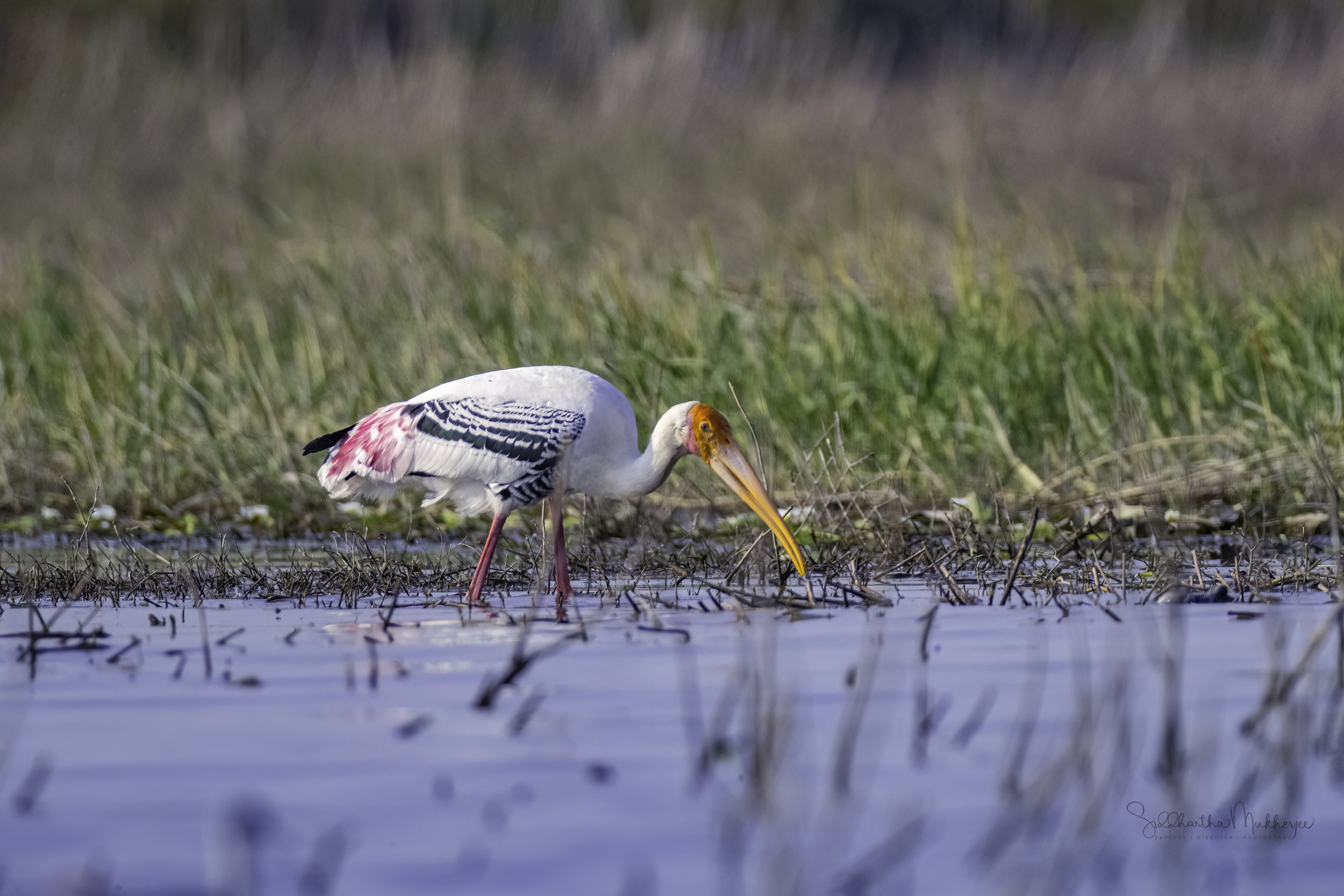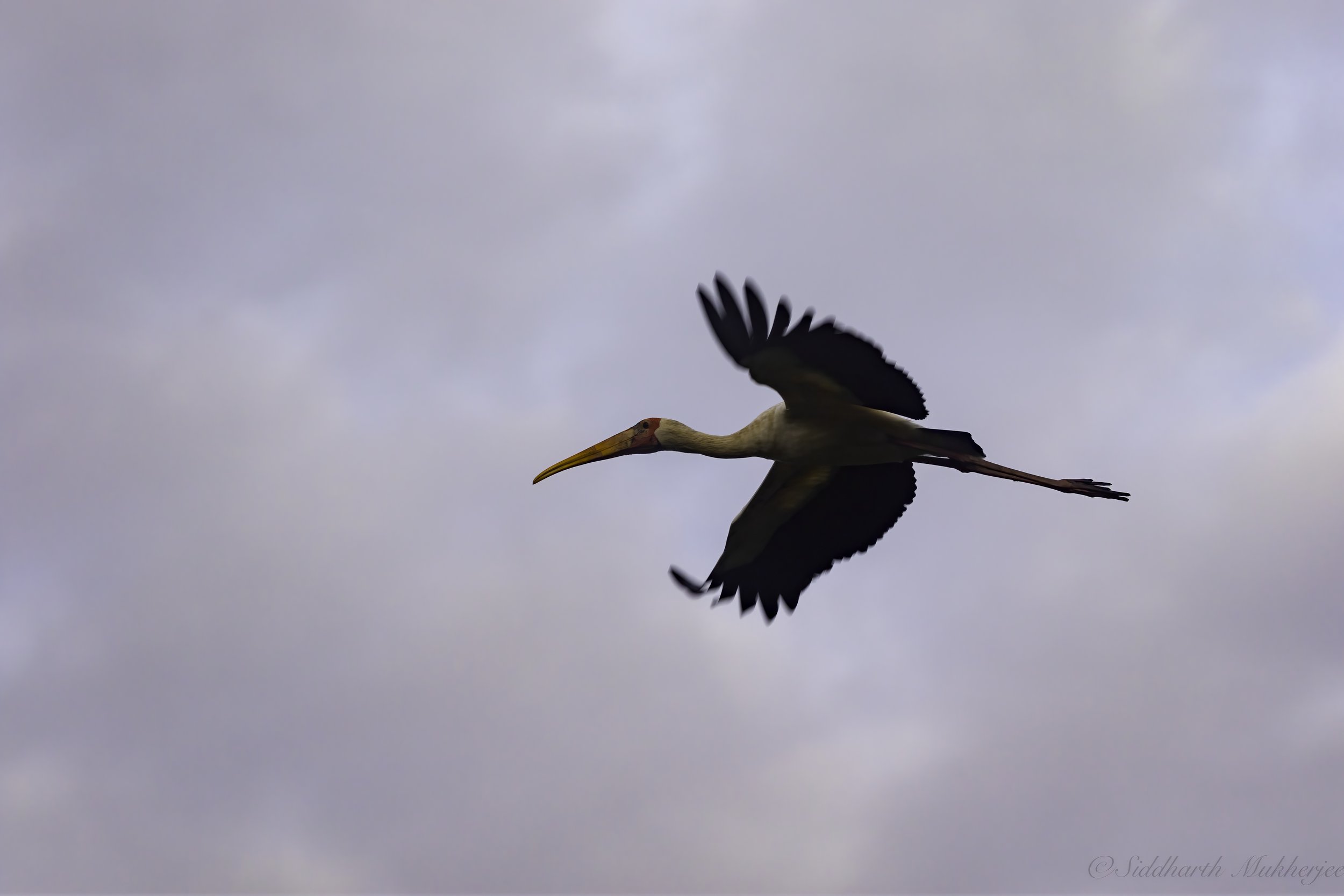Painted Stork
Mycteria leucocephala
Ameenpur Lake, Manjeera Dam, Telangana; Bhigwan Bird Sanctuary; Ranganathittu Bird Sanctuary & Sungei Buloh Wetland Reserve
This week too I am going to continue in the vicinity of the Ameenpur Lake along with some other bird sanctuaries with a very distinctive bird - the Painted Stork. The painted stork is a large wader in the stork family with a long yellow bill that curves down at the tip. It is found in the wetlands of the plains of tropical Asia south of the Himalayas in the Indian Subcontinent and extending into Southeast Asia. Their distinctive pink tertial feathers of the adults give them their name
Lakes and water bodies in Telangana are locally known as cheruvu, kunta & tanks. Quite a few of these lakes, like Tigal Kunta, Somajiguda Tank, Mir Jumla tank, Pahar Tigal Kunta, Kunta Bhawani Das, Nawab Saheb Kunta, Afzalsagar, Nallakunta, Masab Tank etc, have completely disappeared and the surface area of most of the surviving lakes have shrunken and turned into tiny ponds and cesspools. Lakes like the Hussain Sagar Lake, Kunta Mallaiyapalli have shrunk drastically. Of the thousands of water bodies existing in 1970s in various sizes in and around Hyderabad, today only about 70 to 500 of them have survived. Most of them have disappeared due to encroachment or have been illegally drained for real estate projects by private or government agencies. The existing lakes have been used to dump garbage and sewage water.
Most of these lakes and tanks were built during the regime of the Qutb Shahis in 16th and 17th century and later by the Nizams as sources of drinking water for the residents of Hyderabad. The area of Hussain Sagar, which is the largest lake in Hyderabad shrunk by more than 40% i.e. from 550 ha to 349 ha in just 30 years. This lake was built in 1575 AD and since 1930 is not being used as a source for drinking water. Another such lake is the Ameenpur Lake on the western fringe of Hyderabad, surrounded by fantastic primordial rock formations, modern apartments, factories and a village. Ameenpur Lake is an ancient sprawling man-made lake dating back to the time of Ibrahim Qutb Shah, who ruled the kingdom of Golconda between 1550 and 1580. According to one account, the tank was excavated to irrigate a large public garden. The lake is now divided into two parts called Pedda Ameenpur and Chinna Cheruvu.
Ameenpur Lake is a man-made lake reportedly built more than 300 years ago by a courtier, Abdul Qadir Amin Khan of Patancheru, during the reign of Ibrahim Qutb Shah (1550–1580 AD). It was constructed to water his gardens which haven’t survived the ravages of time but the lake itself has, albeit, much smaller in size. The lake is urrounded by fantastic primordial rock formations, modern apartments, factories and a village. In its heyday the lake used to occupy more than 300 acres (1.2 km²), but encroachment and development has reduced it today to a mere 93 acres (0.38 km²). The lake has been divided into two sections, Pedda Ameenpur and Chinna Cheruvu.
The lake is teeming with wildlife, including Bar-headed Geese, Cormorants, Ruddy Shelducks, and Grey Herons. Various resident and migratory birds, such as flamingos, egrets, herons, cormorants, kingfishers, and river terns are among the many local and migratory species that flock to the lake making it a major spot for birdwatchers in Hyderabad. The lake had 186 species in 2016 the time of the last count, up from 171 in 2015. In 2017 it was reported that the lake was home to 8 species of mammals, 166 birds, 45 herpetofauna (12 amphibians and 34 reptiles like the Checkered Keelback & the Oriental Garden Lizard), 9 species of fish, and 143 invertebrates (26 aquatic beetles, 41 butterflies, 18 odonates, 25 arachnids, and 33 other invertebrates). Flamingos are the most common birds found here along with the Oriental Darter, Pallid Harrier, Black-tailed Godwit, Painted Stork, River Tern, and Black-headed Ibis which are among the six species categorised as Threatened on the IUCN Red List. Sometimes, if luck favours, the Greater Spotted Eagle - classified as Vulnerable, and the Egyptian Vulture - classified as Endangered, can be seen soaring the skies here.
Today, because of the vast number of migrating birds that thrive there Ameenpur Lake has the distinction of being the first water body in the country to be declared a Biodiversity Heritage Site. The biodiversity tag was awarded for the Pedda Ameenpur Lake, which is at a higher elevation than Chinna Cheruvu. The Ministry of Environment designated Ameenpur as a Biodiversity Heritage Site in November 2016 under the Biological Diversity Act 2002. It is the first body of water in India to be designated as a Biodiversity Heritage Site, as well as the first biodiversity site to be approved in an urban area.
What is a Biodiversity Heritage Site? These biodiversity heritage sites are a region with great biodiversity that are unique, environmentally fragile ecosystems - terrestrial, coastal, inland and marine waters. They exhibit Species richness including both wild and domesticated species, as well as intra-specific categories. There is a high degree of endemism, rare, endemic, and imperilled species, keystone species, evolutionarily important species, wild forebears of domestic/cultivated species or land races or their variants. There is also predominance of biological components indicated by fossil beds that had cultural or aesthetic value in the past. These sites are important for the preservation of cultural diversity; an area with significant cultural, ethical, or aesthetic characteristics. The State Government, in cooperation with local bodies, may designate sites of biological importance as Biodiversity Heritage Sites under Section 37 of the Biological Diversity Act, 2002.
But that said, there are still threats to this beautiful lake. First the size, it is currently spread over 93 acres which is less than a third of its original 300 acre. This reduction was due to development projects which are still ongoing and may eat into the remaining acreage of the lake. There is also a new cinder block brick kiln that has cropped up on one side. Satellite imagery shows effluents from a chemical factory complex being discharged on the western shores. These discharges along with other industrial pollutants released into the lake has caused a reduction in the food chain of birds such as fish and insects which in turn has led to a reduction in the number of birds visiting the lake. And of course the water itself is unfit for drinking. The number of bird species appears to have decreased, there are fewer trees now, and the lake has a bad odour. The biodiversity tag has the potential to conserve lakes that are otherwise fast disappearing owing to urbanization's effects. This categorization has assisted in the prevention of encroachment and waste dumping. If this lake can be saved, it will serve as an example for other lakes throughout the country.
Located 3 kilometers from the historic town of Srirangapattana and 16 kilometres north of Mysore, Ranganathittu is known as the The Pakshi Kashi (the Kashi for birds just as the city of Varanasi is known and revered by Hindus) of Karnataka. It is a bird sanctuary in the Mandya district of Karnataka & is the largest bird sanctuary in the state. Measuring 40 acres in area it is comprised of six islets on the banks of the Cauvery River.
Ranganathittu's islets were formed when an embankment across the Kaveri river was built between 1645 and 1648 by the then king of Mysore, Kanteerava Narasimharaja Wadiyar. These islets, originally numbering 25, soon started attracting birds. The ornithologist Salim Ali observed that the islets formed an important nesting ground for a large variety of birds, and persuaded the king of Mysore to declare the area a protected area in 1940. The sanctuary is currently maintained by the Forest Department of Karnataka and efforts are ongoing to improve the sanctuary, including purchasing nearby private land to expand the protected area. In 2014, around 28 square km around the sanctuary was declared as an eco-sensitive zone, meaning that certain commercial activities cannot take place without the government’s permission.
The sanctuary with its islets experience heavy flooding during certain rainy seasons when water is released from Krishna Raja Sagara dam upstream, due to heavy rains. During heavy flooding boating is suspended and tourists are allowed to watch the nesting birds from a distance. Frequent flooding has also damaged some portions of three islands over past few decades.
The sanctuary has been designated as a protected Ramsar site since 2022. Ramsar sites are wetland sites designated to be of international importance under the Ramsar Convention, also known as "The Convention on Wetlands", an intergovernmental environmental treaty established in 1971 by UNESCO, which came into force in 1975. It provides for national action and international cooperation regarding the conservation of wetlands, and wise sustainable useof their resources. Ramsar identifies wetlands of international importance, especially those providing waterfowl habitat.
Painted Stork
The Painted Stork (Mycteria leucocephala) is a large wader in the stork family with a long yellow bill that curves down at the tip. It is found in the wetlands of the plains of tropical Asia south of the Himalayas in the Indian Subcontinent and extending into Southeast Asia. Their distinctive pink tertial feathers of the adults give them their name. They forage in flocks in shallow waters along rivers or lakes. They immerse their half open beaks in water and sweep them from side to side and snap up their prey of small fish that are sensed by touch. As they wade along they also stir the water with their feet to flush hiding fish. These storks typically fly with their head and neck drooping almost at or below the belly level. They nest colonially in trees, often along with other waterbirds. The only sounds they produce are weak moans or bill clattering at the nest. They are not migratory and only make short-distance movements in some parts of their range in response to changes in weather or food availability or for breeding. Like other storks, they are often seen soaring on thermals.
This large stork has a heavy yellow beak with a down-curved tip that reminds one of the ibis. The head of the adult is bare and orange or reddish in colour. The long tertials are tipped in bright pink and at rest they extend over the back and rump. There is a distinctive black breast band with white scaly markings. The band continues into the under-wing coverts and the white tips of the black coverts give it the appearance of white stripes running across the under-wing lining.
The rest of the body is whitish in adults and the primaries and secondaries are black with a greenish gloss. The legs are yellowish to red but often appear white due their habit of urohidrosis or defecating on their legs especially when at rest. The short tail is black with a green gloss. For a stork, it is medium-sized, standing about 93–102 cm tall, 150–160 cm in wingspan and weighing 2–3.5 kg. Males and females appear alike but the males of a pair are usually larger than the female.
The downy young are mainly whitish with grey bills and blackish facial skin. The juveniles assume a brownish plumage and like most other storks reach breeding condition after two to three years.
Like all storks, they fly with their neck outstretched and they often make use of the late morning thermals to soar in search of foraging areas. Like other storks they are mostly silent but clatter their bills when they are at the nest and may also make some harsh croaking or low moaning sounds again while at the nest.
This species of stork stands 93 to 102 cm tall and weighs between 2 to 5 kg. Painted storks are the only storks within the genus Mycteria that has a black pectoral band. This species has a long, heavy yellow bill and a yellow face. They display white plumage with a rose color near the tail feathers. Non-breeding plumage is usually less vibrant than breeding plumage. Juveniles are pale brown lacking a pectoral band. Males and females are not sexually dimorphic however, male painted storks tend to be slightly larger than female storks. Body length in this species is used as an indicator of sex. (Ali and Ripley, 1968; Austin, 1961; Urfi and Kalam, 2006)
In the past the species has been placed in the genera Ibis, Tantalus and Pseudotantalus. The slight curve to the beak led them to be considered as a relative of the ibises. The older genus names were based on Greek mythology where Tantalus was punished by having to stand in a pool of water. T C Jerdon called it the "Pelican Ibis". Later studies placed along with the wood-storks in the genus Mycteria, members of which have similar bill structure and share a common feeding behaviour of sweeping their half-open bill from side to side inside water as they wade and their evolutionary affinity has been confirmed by sequence based studies.
The painted stork is widely distributed over the plains of Asia. They are found south of the Himalayan ranges and are bounded on the west by the Indus River system where they are rare and extend eastwards into Southeast Asia. They are absent from very dry or desert regions, dense forests and the higher hill regions. They are rare in most of Kerala and the species appears to have expanded into that region only in the 1990s. They prefer freshwater wetlands in all seasons, but also use irrigation canals and crop fields, particularly flooded rice fields during the monsoon. They are resident in most regions but make seasonal movements. Young birds may disperse far from their breeding sites as demonstrated by a juvenile ringed at a nestin Keoladeo National Park that was recovered 800 kilometres away at Chilka in eastern India. Breeding is always on large trees, usually in areas where nesting trees are secured over long periods of time, including in wetland reserves, along community-managed village ponds and lakes, inside villages when protection is also afforded to nesting birds like in Kokrebellur, protected tree patches in urban locations such as zoos, and on islands in urban wetlands.
Painted storks feed in groups in shallow wetlands, crop fields and irrigation canals. The maximum success of finding prey was at 7 cm of water depth at Keoladeo-Ghana National Park. They feed mainly on small fish which they sense by touch while slowly sweeping their half open bill from side to side while it held submerged. They walk slowly and also disturb the water with their feet to flush fish. They also take frogs and the occasional snake. They forage mainly in the day but may forage late or even at night under exceptional conditions. After they are fed they may stand still on the shore for long durations. Flock sizes in agricultural landscapes are mostly small (<5 birds) but reach flocks of over 50 birds. In such landscapes, flock sizes do not vary much between seasons, but densities are much higher in winter after chicks of the year have fledged from nests. Painted storks breed on trees either in mixed colonies along with other water birds, or by themselves. The breeding season begins in the winter months shortly after the monsoons. In northern India, the breeding season begins in mid-August while in southern India the nest initiation begins around October and continues till February and or even until April.
The typical clutch varies from one to five eggs with early breeders having larger clutches. The incubation period is about a month while the fledging period is nearly two months. There is occasional predation of chicks by migrant Aquila eagles and Pallas's fish eagle. During the mid-day heat, adults will stand at the nest with wings outstretched to shade the chicks. To feed chicks, adults regurgitate fish that they have caught and these are typically smaller than 20 cm long. Young chicks, when threatened, disgorge food and feign death by crumpling to the nest floor. Nest survival (measured as daily nest survival) is higher for nests initiated early in the monsoon season, lower with decreasing temperature, and higher at larger colonies. The bare red skin on the head is developed when reaching breeding maturity and involves the loss of feathers and the deposition of lipids under the skin. Birds in captivity have been known to live for as long as 28 years. Birds raised as chicks have been known to be tame and docile, even responding to their names when called.
Both male and female painted storks share responsibilities when incubating and raising young. The young are born altricial, without feathers and with eyes closed. Each parent will take turns feeding nestlings until they fledge. Painted storks are predated by tigers (Panthera tigris), leopards (Panthera pardus), hyenas (Hyaenidae), crocodiles (Crocodylidae), and eagles (Accipitridae). Predation is most significant during the breeding season when eggs and defenseless chicks are available. As a method of defense, chicks will vomit and lie motionless to appear dead. Humans are another common predator of painted storks. Fisherman in local villages capture chicks and sell them to animal collectors. Storks are also collected for food in rural villages.
A bird louse, Ardeicola tantali was described on the basis of a specimen obtained from this species as also a subcutaneous mite, Neottialges kutzeri, of the family Hypoderidae.
Painted stork nesting colonies often become centres of tourist attraction due to their large size and colour. Particularly well-known nest sites close to human settlements are in the south Indian villages of Kokrebellur and Veerapura. In Kokrebellur, the birds nest within the trees in the village forming mixed nesting colonies with the spot-billed pelican. The local people provide security to these birds during the brief nesting season when the birds arrive in October and until they leave the village after a couple of months. Another well-known colony that has been studied since the 1960s is the one inside the Delhi Zoological Park where the birds arrive about 30–40 days after the onset of the monsoons in Delhi. This colony is made up of 300 to 600 wild birds that make use of the trees within the artificial islands inside the zoo. Uppalapadu village near Guntur in Andhra Pradesh, Kolleru, Gowtavaram Village in Andhra Pradesh and Ranganathittu are among the many other breeding colonies known from southern India. I have also seen colonies at the Manjeera Dam and other large water bodies in Telangana. The largest secure population is found in India. Birds in Pakistan along the Indus River system are endangered and chicks at their nests are taken away for the bird trade. The species was nearly decimated in Thailand while small populations are known from Cambodia and Vietnam.
There are some concerns for the closely related milky stork owing to hybridization with the painted stork, particularly in zoos. Hybrids have been recorded in the wild in Cambodia and in several zoos including those at Kuala Lumpur, Singapore Zoo and Bangkok. Hybridisation with lesser adjutant storks have also been recorded in several zoos, especially at the Colombo Zoo, Sri Lanka where a male painted stork and female lesser adjutant mated and reared chicks several times.
‡‡‡‡‡
Related Posts


